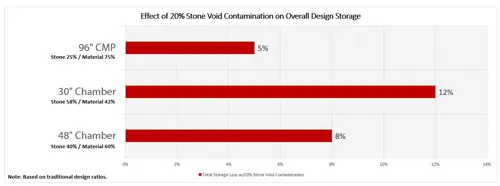
Examining Stone Void Space Part 2: How To Minimize the Reliance on Stone Voids for Storage
How to Minimize Dependence on Stone Void Space in Stormwater Systems
In part one of this series (Is 40% a Reliable Number?), we examined new research that showed the generally accepted number of 40% porosity (also hereby referred to as “stone voids”, and “void space”) within the stone backfill as available storage might not be a reliable number. To obtain a 96% reliability in stone storage, 36% stone void storage should be considered in the design. This has significant implications, as stormwater detention systems often include a large portion of the storage volume within the voids of the backfill material. But there is no going back when it comes to the occlusion of stone voids; once they are filled, the storage capacity is permanently lost. Therefore, the end goal for engineers should be to minimize the reliance on stone voids for storage. By doing so, you maintain as much of the storage design as possible, reducing downstream concerns.
How do you do that? The easiest way is to use the largest diameter corrugated metal pipe (CMP) the site will allow. The graph below illustrates this. The graph looks at the effect of 20% stone void occlusion over time, and the impact it has on overall design storage using various materials and sizes.

With 96” CMP, the storage loss is 5%. With a 30” chamber, the loss is more than double that of the CMP at 12%. The reason for this is that by their nature, chambers are naturally more sensitive to occlusion because a high percentage of the designed storage space depends on stone voids to achieve the total storage volume. This is indicated by the material to stone ration shown on the left-hand side of the chart. With the 96” CMP, 25% of the storage volume comes from the stone. For the 30” chamber, this number increases to 58%, a significantly higher proportion.
Another way to look at this is the storage capacity within the material can be maintained over time, but storage capacity within the stone voids cannot. Therefore, the material that provides the most storage capacity will result in less risk for specifiers and provide the most reliable long term storage solution.
